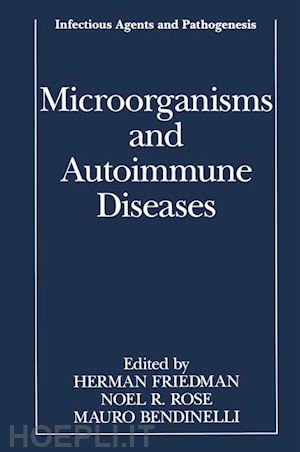1. Bacterial Heat-Shock Proteins and Autoimmune Disease.- 1. Introduction.- 2. Peripheral Tolerance, Autoimmunity, and Environmental Bacteria.- 3. Experimental Models Support a Critical Role of Specific Immunity in Autoimmune Diseases.- 4. HSP60 and the Inhibition of Experimental Arthritis.- 5. Responses to Human HSP60 in Juvenile Chronic Arthritis.- 6. Lessons for the Development of Specific Immunotherapy in Autoimmunity.- References.- 2. Streptococci and Rheumatic Fever.- 1. Introduction.- 2. Historical Perspective.- 3. Clinical Features.- 4. Etiology: The Group A Streptococcus.- 5. Epidemiology and Host Susceptibility.- 6. Autoimmune Pathogenesis of Acute Rheumatic Fever.- 7. Animal Models of Rheumatic Heart Disease.- 8. Treatment and Prevention.- References.- 3. HLA-B27, Enteric Bacteria, and Ankylosing Spondylitis.- 1. Introduction.- 2. One- and Two-Gene Theories.- 3. Description of HLA-B27-Associated Disease Markers in the Pathogenesis of Ankylosing Spondylitis.- 4. Evidence for HLA-B27-Restricted Cytotoxic T Lymphocytes in the Pathogenesis of Ankylosing Spondylitis and Other Seronegative Arthropathies.- 5. Conclusions and Future Directions.- References.- 4. Triggering of Autoimmune Antibody Responses in Syphilis.- 1. Introduction.- 2. Overview of the Disease.- 3. Immune Complexes and Autoimmune Responses in Syphilis.- 4. Polyclonal B-Cell Activation.- 5. Idiotypic Networks.- 6. Molecular Mimicry.- 7. Concluding Remarks.- References.- 5. Viruses and Diabetes Mellitus.- 1. Introduction.- 2. Viruses and Autoimmune Diabetes.- 3. Interferon and Diabetes.- 4. Molecular Mimicry between Viruses and Beta-Cell Autoantigens.- 5. Transgenic Models of Virus-Induced Diabetes.- 6. Concluding Remarks.- References.- 6. The Role of Coxsackie B Viruses in the Pathogenesis of Type IDiabetes.- 1. Introduction.- 2. Epidemiological Studies.- 3. Difficulties Encountered in Epidemiological Studies on the Relationship between Coxsackie B Viral Infections and IDDM.- 4. Case Reports and in Vitro Studies on Human Islet Cells.- 5. Animal Studies.- 6. Mechanisms for Coxsackie B Virus-Induced Diabetes.- 7. Concluding Remarks.- References.- 7. Neuropathic Viruses and Autoimmunity.- 1. Neurotropic Infection.- 2. Virus Entry and Infection.- 3. Acute Infection.- 4. Persistent Viral Infections.- 5. Viral Complications of Immunosuppression.- 6. Parainfectious Syndromes.- 7. Discussion and Conclusions.- References.- 8. Postmeasles Encephalomyelitis.- 1. Introduction.- 2. Postmeasles Encephalomyelitis.- 3. Viral Induction of Autoimmune Disease.- 4. Autoimmune Destruction of Myelin.- 5. Additional Mechanisms of Viral Demyelination.- 6. Conclusion.- References.- 9. Epstein-Barr Virus and Autoimmunity.- 1. Introduction.- 2. The Epstein-Barr Virus.- 3. EBV-Related Diseases.- 4. Autoimmune Diseases Possibly Related to EBV.- 5. Autoimmunity in Infectious Mononucleosis.- 6. Conclusions.- References.- 10. Retroviruses and Autoimmunity.- 1. Introduction.- 2. Retroviruses and Autoimmune Disease.- 3. General Biology of Retroviruses.- 4. Classic Autoimmune Disorders and Associations with Retroviruses.- 5. Summary.- References.- 11. Autoimmunity in Chagas Disease.- 1. Introduction.- 2. Uncommon Molecular Features of Trypanosoma cruzi.- 3. The Paradox of Antigen-Driven Delayed-Type Hypersensitivity.- 4. The Paradox of the Severe Forms of Acute Chagas Disease in Santiago del Estero Infants.- 5. Downregulation of the Immune Response.- 6. Autoreactive Organ-Specific Delayed-Type Hypersensitivity and Autoantibodies.- References.- 12. Infection and Endocrine Autoimmunity.- 1. Introduction.- 2. The Potential Role of Infection in Autoimmunity.- 3. Autoimmune Thyroid Disease.- 4. Pituitary and Polyendocrine Autoimmunity.- 5. Conclusion.- References.- 13. Infection as a Precursor to Autoimmunity.- 1. Introduction.- 2. Myocarditis.- 3. An Animal Model of Myocarditis.- 4. Genetics of Autoimmune Myocarditis.- 5. The Role of Cytokines.- 6. Myosin as Autoantigen.- 7. Discussion.- References.












